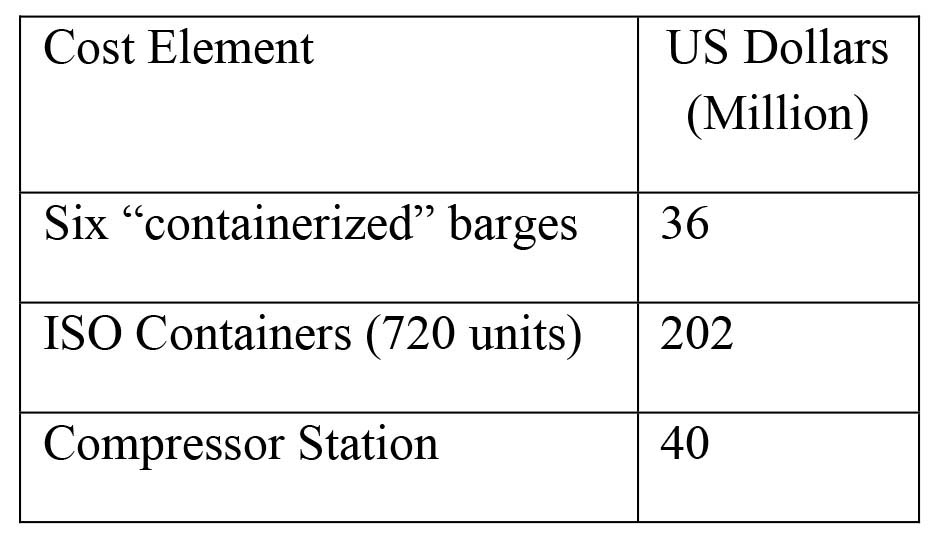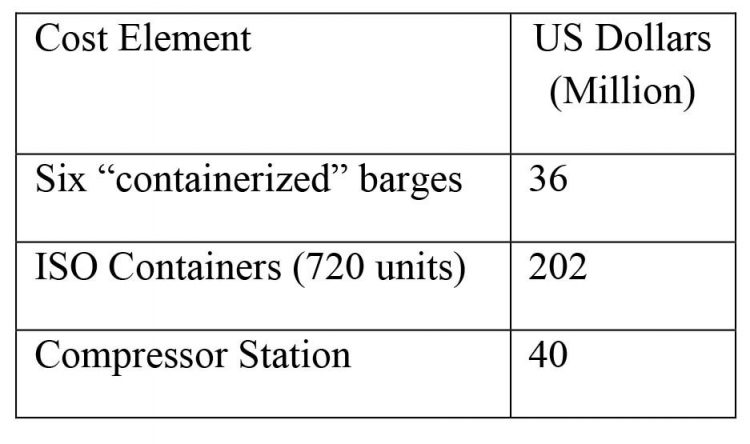Dear Editor,
Recent “Letters to the Editor” have sought to question the viability of transporting gas to shore by ship. Editor, it can be said categorically, that gas to shore by vessel as compressed natural gas (CNG), is a fraction of the cost of the present pipeline plan of the Government.
Elements of an option of CNG by vessel
One option investigated involves the use of self-propelled barges each loaded with 120 ISO containers. Each container would hold 9 tons of CNG at a pressure of 250 bar. Four barges would be required to transport 50 million standard cubic feet per day. The barges would travel at a rated speed of 10 Kn. when fully loaded, and, have a turn-around time of 36 to 48 hours, inclusive of time to “cascade” load and discharge. Six barges are proposed in the cost estimates below, to cater for planned maintenance and unforeseen downtime.
Capital Cost Estimate
Using quotations received from equipment manufacturers a year ago, the costing of the core element of this transportation option, is as follows:
This option would therefore transport 50 mmscf/day gas to shore at less than US$300 million.
Other Benefits of Gas to shore by Barge
(1) With a draft of 4.2 meters when fully loaded, the barges allow access to most GPL generating locations. The existing generating and transmission assets of GPL would continue their useful lives, with the addition of units as short term demand grows. Plans for the installation of cost effective renewable power could be implemented as soon as practicable to supplement natural gas power generation.
(2) The barges would act as storage buffers in the event of an unexpected interruption of gas supplies, thereby reducing the need for extensive storage tanks at GPL locations.
(3) Barges allow flexibility in the sourcing of gas from any FPSO, and, opens the possibility of multiple destinations, local or to nearby countries. In addition, scaling up gas volumes could be economically and quickly achieved.
(4) Barges conveniently allow planned or unplanned maintenance. Shutting down a pipeline for maintenance, especially in an event occurring in deep water, is likely to be a very expensive and dislocating operation.
CNG Transportation by ISO Containers is mature technology.
There are thousands of applications around the world, where CNG is transported overland in pressure vessels, such as the ISO containers. Maritime applications are few, but uniquely fit the Guyana context, with our geographic realities of a “mud flat” all along the coast, natural gas sources spread out in deep water a hundred miles off shore. These realities make constructing pipelines hugely expensive. So expensive that the present US$1.3 billion pipeline plan would drive up the cost of gas delivered to shore to over US$ 8.00 per million Btu, (compared with a present price of natural gas of US$3.50 in the United States), and would actually increase GPL’s generating cost when crude oil prices are at or below US$80.00 per barrel. In comparison, the gas transportation cost of the barge option above, would be less than US$2.00 per mm Btu.
An example of a maritime transportation of CNG by ISO container can be viewed at: https://vimeo.com/503167266
Sincerely,
Fitzroy Fletcher







